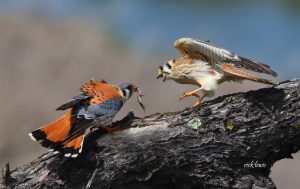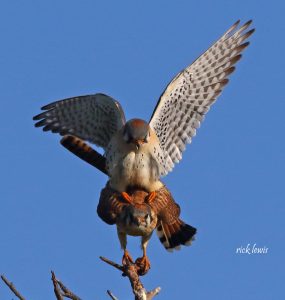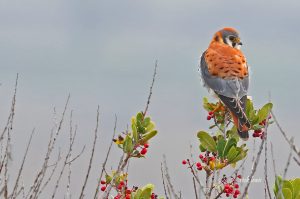The American Kestrel’s Mysterious Decline
By Taylor Crisologo
Crickets chirped, hidden somewhere in the brown ocean of grass beside the trail. The sun cast a golden glow on the hills, dotted with oak trees. In the distance, a lone American Crow called. It was an hour before sunset, and we were making our way along the trail in search of American Kestrels.
“There’s one!” Dan exclaimed, pointing to a small, dove-sized bird hovering above the trail ahead of us. Laughing at the fact that Dan always seems to find the birds first, I brought my binoculars up to see an energetic male hovering with feet outstretched. This “hover hunt” is a hunting tactic occasionally used by American Kestrels, allowing them to have a bird’s eye view of the habitat below to locate their next meal.

We moved off the trail to watch him, listening passively to the sounds of Anna’s Hummingbirds chirping and Oak Titmice calling around us.
Dan and I have seen American Kestrels before – both resting on telephone wires lining agricultural fields in Ithaca, New York and perched on bleached branches of dead trees above the grassland in the South San Francisco Bay. Their familiarity to us is largely due to their widespread range, which extends across the United States.
American Kestrels are birds of prey, feeding on insects, reptiles, and small birds and mammals. They are secondary cavity nesters, meaning that they lay their eggs in cavities excavated by other animals. In addition to their interesting life history, American Kestrels are fun, dynamic birds to watch. Even at rest, their head and tail bobbing give them an impatient demeanor, as if they’re itching to rise up in flight.

Sadly, populations of these personable birds are experiencing a grim reality check across North America. Data on population numbers, from sources including the U.S. Geological Survey’s Breeding Bird Survey (BBS) and the National Audubon Society’s Christmas Bird Count, indicate that American Kestrel populations have been declining across the United States for decades. Data from the Peregrine Fund’s American Kestrel Partnership and BBS suggest that kestrel populations in coastal California have suffered declines since the 1960’s.
Scientists are unsure about the “one true cause” of kestrel declines. It seems that multiple causes may be working together to reduce kestrel populations each year. These causes may also vary by region, making one simple answer very difficult to determine. However, that’s not to say that scientists don’t have some ideas as to what could be contributing to the kestrel’s decreasing numbers.

American Kestrels prefer open habitats, as they are well-suited for locating and dispatching their prey. Loss of their preferred habitats due to development and shifting land usage, as well as a loss of trees whose cavities they need for nesting, could be contributing to their decline. Competition for nest sites with other secondary cavity nesting birds, such as the invasive European starling, is also a cause for concern.
To address the needs of breeding kestrels, many organizations and local efforts have turned to building artificial kestrel boxes to offer breeding pairs refuge. Placement of artificial nest boxes has historically helped kestrels; however, recent studies show that their nest box use has been declining in certain areas. This finding suggests that certain populations of kestrels are succumbing to threats beyond just lack of nest cavity availability. However, despite these mixed results, the construction and monitoring of nest boxes provides critical data on kestrel numbers. This is exceedingly important as we race to understand what’s affecting their populations.

Rachel Carson’s Silent Spring worked to shed light on the harmful effects of DDT, leading to bans of the pesticide in the U.S. This was a huge success for large raptors such as peregrine falcons and bald eagles, but scientists are now concerned about the effects of other pesticides on smaller raptors. Neonicotinoid insecticides, in particular, are worrying scientists, as they have been shown to negatively impact insectivorous birds in the Netherlands. More research on the direct effects of current pesticide use on our small raptors is needed to elucidate its threat.
Concerned organizations are also questioning the effects of rat poisons on local kestrel populations. Anticoagulant rodenticides are a particularly nasty poison, working by disrupting the affected animal’s ability to form blood clots and ultimately leading to death. However, anticoagulant rat poison does not always kill its victims immediately – sometimes, affected animals will exhibit signs of lethargy before dying. The lethargic behavior prior to death makes the rodent an easy target, leading to poisoned kestrels and other predators. To combat these effects locally, refrain from using anticoagulant rat poisons (namely poisons that contain the compounds bromadiolone, brodifacoum, diphacinone, and difethialone) and spread the word to your community.
We watched the kestrel for some time, standing just off the trail. The kestrel hovered mid-air, staying still except for beating wings. He suddenly swooped down and lifted back up in one graceful maneuver, then resumed hovering a few feet from his original place.
The future for our kestrels is uncertain, but we can make choices in our community to help guide it in the right direction. We can each do our part by promoting awareness of the threats that kestrels face, reporting sightings of adults and breeding pairs regularly, and by being active voices in our local organizations.

I took out my field notebook to record our sighting of the American Kestrel, noting the time and location. We stood silently, following the kestrel back to his final perching place as the sun set behind us.
Taylor Crisologo lives in the South Bay, where she avidly birds and runs a site on Bay Area nature (www.bayareanaturalist.com). She studied biology at Cornell University, where she worked with the Cornell Lab of Ornithology on projects ranging from breeding herring gulls off the coast of Maine to dancing lyrebirds in Australia’s Blue Mountains.
